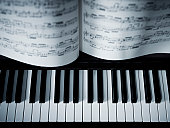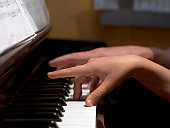
Home > Piano Techniques
|
Learn the Various Piano Techniques(Scroll down to see the full list of lessons in this section)
They enable you to develop proper methods while eliminating any imperfections. You do not need great dexterity or quick reflexes in order to master the piano. Anybody who sets forth confidently in order to play piano will succeed as long as they possess proper techniques. In order to accurately program your hands, practice is key in order to develop brain and nerve connections. Practice really does make perfect, so practice routinely in order to sharpen your piano skills. Many people confuse technique with dexterity, but this is not the case. Many individuals with limited movement are capable of successfully playing the piano without impairment. Technique is your collection of skills which allows you to play diverse pieces of piano music. It is very important to learn them correctly the first time around. If you decide to alter a task, it will hinder you from properly synchronizing your brain and your hands. For example, when learning to read notes, do not write its corresponding letter on the sheet of music. By immediately training your mind to read sheet music it will create passageways from your head to the tips of your fingers. Absorbing any new piano technique requires two simple steps. First, you must find the most comfortable suggested placement for your arms, hands and fingers; followed by the conditioning of your muscles, nerves and brain.
Curve your fingers and use the tips of your fingers when playing, this will allow you to have power and strength when playing. It is also very important to not stop at each bar line, slow down and try to play the whole song without stopping. The hours spent in front of your piano practicing your scales and chords will not be time waster. This form of memorization and practice will aid the development of intellectual and memory skills and aid in accomplishing tasks throughout the day. Studying will become easier because you’ll have a better memory and problem solving skills. When learning new types of music you will have to learn new concepts. Many young pianists believe that once they have mastered the basics, they are capable of playing any form of piano music. This is untrue. When learning new pieces of music you will undoubtedly have to learn new techniques and concepts. Experienced pianists can play new pieces of sheet music without difficulty because they have practiced over and over again. In addition, they have acquired the ability to learn new methods quickly and efficiently. Comparing yourself to other pianists will never do you justice. Professional pianists worked hard and long hours in order to achieve this ability, and therefore you should too!
http://pianoplayerworld.com/300PagePianoWorkbook.html Lessons on Piano Playing Techniques:
|
|
Although every attempt has been made to make information as accurate as possible, we are not responsible for any errors that may appear.
 In order to properly execute any form of piano music, you must understand
the importance of piano techniques. Perfected techniques will aid in the fundamental
In order to properly execute any form of piano music, you must understand
the importance of piano techniques. Perfected techniques will aid in the fundamental 
 Practicing them over and over again is necessary to successfully execute new
skills with ease and control. Begin by practicing slowly, paying close attention to which notes are being
played. The slow process of augmenting your speed will help create connections between your hands and your
mind.
Practicing them over and over again is necessary to successfully execute new
skills with ease and control. Begin by practicing slowly, paying close attention to which notes are being
played. The slow process of augmenting your speed will help create connections between your hands and your
mind.




